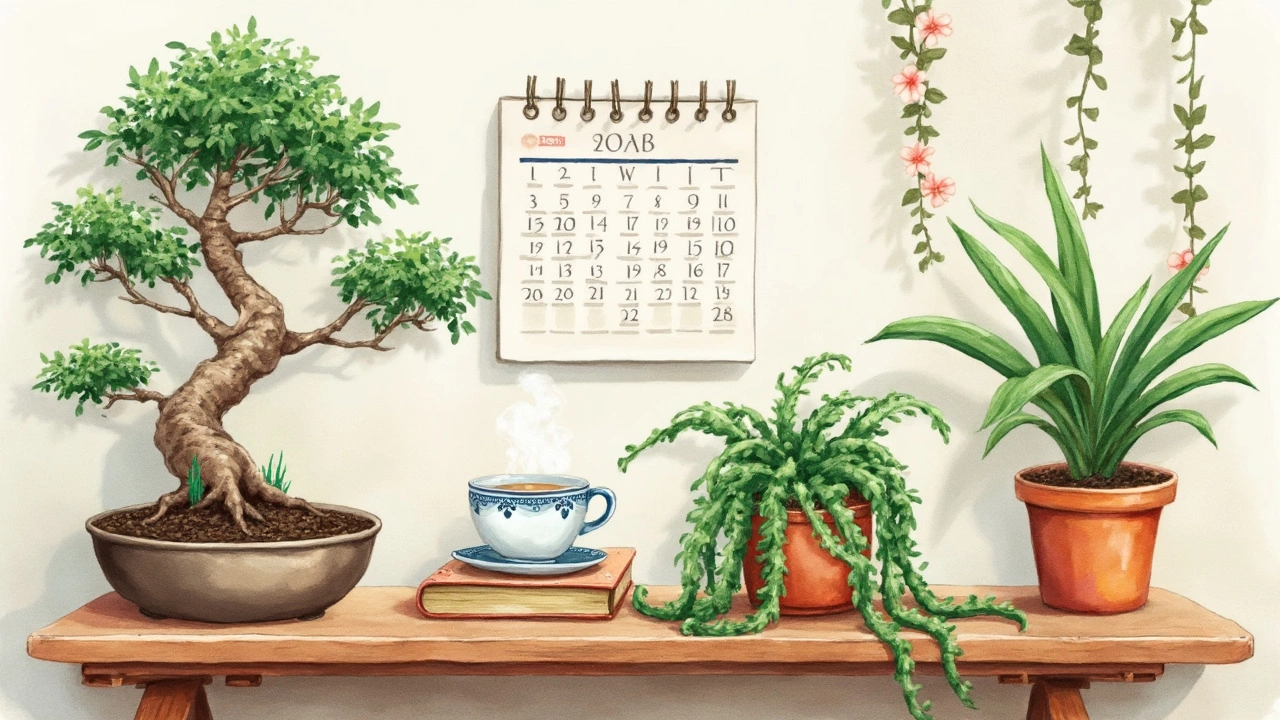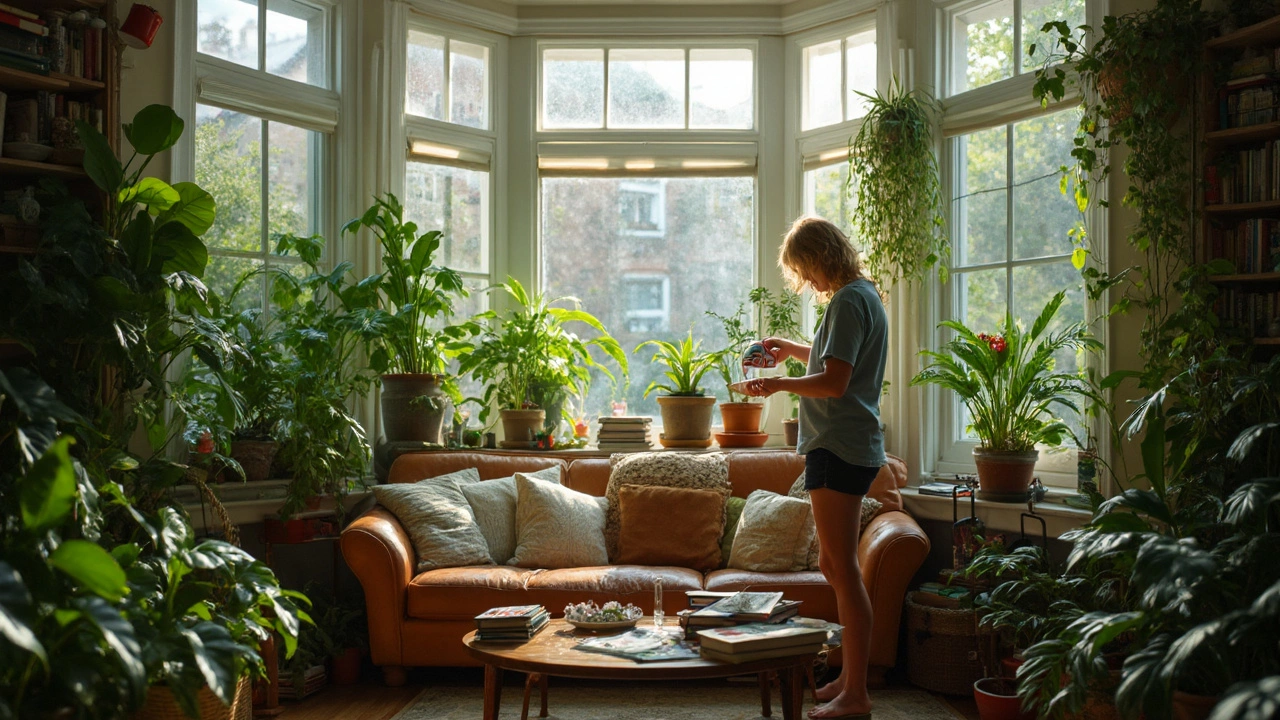Ever wondered why that peace lily lasted ages on your grandma’s windowsill, but your fancy fern croaked after a year? Truth is, there’s no one-size-fits-all answer for how long indoor plants last. Some barely scrape past a year, while others can outlive your oldest childhood memory—if you give them what they need.
Here’s what really decides a plant’s indoor life span: its species, how well you treat it, and sometimes just plain luck. Think of plants like people—some are built to handle anything you throw at them, while others freak out if you move them an inch. Watering, light, food, and even your apartment’s dodgy heating system all play a part.
Want the honest numbers? Some small potted annuals call it quits after one season, but sturdy types like snake plants and ZZ plants have been known to live for decades (yep, decades). If you want your plant to stick around, a few care tweaks can make a massive difference. Light’s a biggie—don’t tuck your plant in a dark corner and expect magic. And about watering, most plants actually die from too much, not too little. Let the soil dry out a bit before water top-ups, unless you’ve got a water-loving type like the peace lily or calathea.
- What Determines a Plant’s Life Span?
- Common Houseplants and Their Typical Life Expectancy
- Secret Sauces: How to Make Indoor Plants Live Longer
- When It’s Just Not You—Signs a Plant’s Time Is Up
What Determines a Plant’s Life Span?
There’s a bunch of reasons why some indoor plants stick around for years, while others bite the dust way sooner. The main factors? Type of plant, environment, and how you treat it on a daily basis.
First up, genetics matter. No matter how great your care game is, some houseplants are just wired to live longer. Take annuals and perennials—annuals (like basil) are meant to finish their cycle in less than a year, while perennials (like a snake plant) can keep coming back every season, often living decades indoors.
| Plant Type | Average Life Span Indoors |
|---|---|
| Basil (annual) | 4-6 months |
| Peace Lily (perennial) | 3-5 years, sometimes longer |
| Snake Plant (perennial) | 10+ years |
| ZZ Plant (perennial) | Up to 20 years |
Environment can make or break your houseplants. Too little light and they’ll barely grow. Too much water? That’s a fast track to root rot (especially for things like succulents). Most indoor favorites like consistent temps—sharp drafts or super dry heating air can send sensitive types into a tailspin.
Your personal plant-care routine is a deal breaker. Forget to water, and you’ll see wilting pretty quick. Overwater or skip fertilizer, and your plant either drowns or goes nutrient-hungry. Repotting matters, too. If roots get crammed, the whole plant can stall out.
Let’s be real: Not every plant is fussy, but even the hardy ones won’t last if you totally ignore them. Spot issues early (yellow leaves, droopy stems) and change things up fast. You’ll end up with plant life span numbers closer to the high end, instead of buying a new pothos every year.
Common Houseplants and Their Typical Life Expectancy
If you’ve spent any time shopping for indoor plants, you’ve probably noticed there are a handful of MVPs that everyone has. Each has its own time limit—some are sprinters, others are marathon runners. Here’s how long you can realistically expect some of the most popular houseplants to last in your home.
- Peace Lily – These beauties usually stick around for 3-5 years, but if you repot them every year and don’t let them dry out, you might get closer to a decade.
- Snake Plant – Hands down one of the easiest and longest-living options. A healthy snake plant has been known to roll on for over 25 years if you don’t drown it.
- Pothos – These tough vines are made for beginners and can last 5-10 years, even longer if you give them indirect light and trim wayward stems.
- Spider Plant – Give them a bit of love and they’ll easily live past their fifth birthday, sometimes even hitting 10 if you routinely snip dead leaves and “pups”.
- Zamioculcas zamiifolia (ZZ Plant) – Legendary for surviving neglect. A well-looked-after ZZ can hit 20 years and counting.
- Rubber Plant – With some basic care, rubber plants can stick around for 10-15 years, sometimes even longer if they get plenty of bright, indirect light.
- Aloe Vera – Most folks keep aloe plants around 5-12 years. They hate overwatering but love a sunny spot.
- Phalaenopsis Orchid – Blooms might last months, but with a rest period and good care, the plant can survive 5-8 years easily.
| Plant | Life Expectancy (Years) | Care Highlights |
|---|---|---|
| Snake Plant | 15-25+ | Thrives on neglect, hates soggy roots |
| Pothos | 5-10+ | Low light, easy to propagate |
| Peace Lily | 3-10 | Keep soil moist, avoid direct sun |
| ZZ Plant | 10-20+ | Low water, low light, tough as nails |
| Spider Plant | 5-10 | Trim babies, medium light |
Keep in mind, these numbers aren’t guarantees. Even a “long-lifer” can go downhill fast if you ignore plant care basics. And yeah, sometimes a plant just gives up for no reason you can figure out. But knowing these typical life spans, you can pick houseplants that fit your lifestyle (and your patience level).

Secret Sauces: How to Make Indoor Plants Live Longer
Let’s get right into what actually helps indoor plants stick around for years. A huge part boils down to what you do daily, weekly, and monthly. Small changes add up—ignore them, and your plant’s life span drops fast.
- Light is everything. Put your plant as close to its natural sunlight needs as possible. Most houseplants don’t like blazing sun, but sticking your pothos in a dark hallway will kill it just as fast. South or east-facing windows are great for most types. If you live in a basement apartment or have shady spaces, grow lights can literally save your plant’s life.
- Water smart, not often. Here’s the classic mistake: killing with kindness by overwatering. Stick your finger in the soil about an inch—if it feels dry, then it’s time for a drink. Most indoor plants would rather you underwater than swamp their roots.
- Humidity matters more than you think. Plants like ferns, calatheas, and peace lilies thrive in bathrooms or areas where you shower a lot. If your home’s dry, use a tray of water with pebbles, or just group your plants together to make a mini humidity zone.
- Go easy on the fertilizer. Feeding your houseplants is good, but too much turns soil salty and ruins roots. In spring and summer, fertilize once a month with a balanced liquid plant food. Skip feedings in winter when the plant slows down.
- Pick the right pot and soil. Always use pots with drainage holes to avoid soggy roots. Don’t just grab random soil from the yard—get a good houseplant mix, or tweak with perlite for air flow.
| Plant Type | Best Life-Extending Tip | Average Indoor Life |
|---|---|---|
| Snake Plant | Let soil dry between waterings | 10+ years |
| Pothos | Indirect light, occasional pruning | 5-10 years |
| Peace Lily | High humidity, no direct sunlight | 3-5 years |
One overlooked trick: wipe the dust off your plant’s leaves once a month. Dirty leaves can’t get enough light, so they start to decline early. And don’t forget, switching up to a bigger pot (only when roots poke out the bottom) gives roots room to grow—no need to rush or over-pot.
In short, the best way to make your indoor plants last is to pay attention. Make small changes, keep an eye out for droopy leaves or mold, and act fast if something seems off. Your plants will pay you back with years of loyal company.
When It’s Just Not You—Signs a Plant’s Time Is Up
It’s easy to blame yourself when an indoor plant starts going downhill, but the truth is, every plant has an expiration date. Even top-tier plant care can’t keep some species going forever. Here’s how to figure out if it’s time to say goodbye, no matter how many hacks you've tried.
First, watch for leaves that keep yellowing or dropping off, even after you’ve adjusted water, light, and fertilizer. Sure, a few rough patches aren’t a death sentence—but if your plant is more bald than leafy and new growth just won’t stick, it’s probably nearing the end.
Another red flag is when roots start circling the bottom of the pot (root bound) and even repotting or trimming doesn’t perk things up. Sometimes, older houseplants just slow down for good. Plants like spider plants or pothos get “tired” after several years, producing fewer or punier leaves with every new season.
Take a quick look at your plant’s stems or crown. If they’re getting mushy, brown, or rotten, especially after watering less and improving drainage, it might be game over. This usually means rot has set in, which is tough to reverse once it's deep.
Here’s a quick cheat sheet for spotting end-of-life signs:
- Consistent leaf drop and no new healthy growth
- Stems stay limp or mushy even after proper watering changes
- Roots filling the entire pot with no healthy new shoots
- Frequent pest or fungal problems that keep coming back
- Stunted growth or tiny, weak leaves for more than one season
If you’re seeing three or more of these in your plant maintenance routine, it might be time to start fresh. Don’t feel bad—some plants are just built to be short-lived, and many (like annual flowering plants) aren’t supposed to last more than a year indoors.
Here’s a simple table showing common indoor plants and their typical maximum lifespans when cared for properly:
| Plant | Maximum Lifespan Indoors |
|---|---|
| Spider Plant | 2-5 years |
| Pothos | 5-10 years |
| Snake Plant | 10-25 years |
| Peace Lily | 3-5 years |
| Fiddle Leaf Fig | 10-15 years |
Plants get old, just like pets or people. Sometimes, no amount of expert indoor plant care will revive them. When you notice your green friend isn’t bouncing back, don’t hesitate to compost it and pick out a new sidekick for your shelf. It’s part of being a plant parent.
